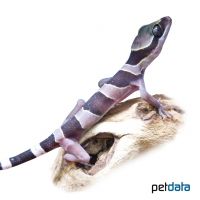Malayan Forest Gecko (Cyrtodactylus pulchellus)
| Malayan Forest Gecko Cyrtodactylus pulchellus | |
|---|---|
| Name | Malayan Forest Gecko |
| Name Lat. | Cyrtodactylus pulchellus |
| Family | Geckos |
| Family lat. | Gekkonidae |
| Order | Scaled Reptiles |
| Order lat. | Squamata |
| Origin | Southeast Asia |
| Habitat | Rainforests |
| Diet | Insects |
| Humidity | 75-95 % |
| Behavior | Nocturnal; ♂ territorial |
| Keeping | Individual, pair, harem |
| Care Level | Moderate |
| Reproduction | Oviparous |
| Housing | Humid terrarium |
| Life Span | 5-7 years |
| Protection | No |
| Metric Units | |
| Size | 26 cm |
| Temperature | 26-28 °C |
| Temperature Local | 30-35 °C |
| Housing Size | 60 x 50 x 40 cm |
| US Units | |
| Size | 10.2" |
| Temperature | 79-82 °F |
| Temperature Local | 86-95 °F |
| Housing Size | 25" x 20" x 15" |
Distribution and habitat
The crepuscular to nocturnal, predominantly ground-dwelling Malayan bow-fingered geckos inhabit the tropical rainforests and humid forests of Thailand, Burma and western Malaysia up to 1,300 m above sea level. There they live hidden under stones and roots.
Maintenance
Recommended minimum dimensions for the terrarium, according to the size and number of animals
| 1-2 animals | 4KRL x 3KRL x 2KRL (L x W x H) |
Head-torso length (KRL) is measured on the largest animal. For each additional animal, increase the footprint by 15%. A terrarium of e.g. 60 x 50 x 40 cm is recommended, which should be placed in a quiet and vibration-free place
You need a terrarium structured with roots and stones (hiding places and visual protection), a graveable substrate of sand-earth mixture (terrarium humus), a shallow water bowl and potted plants (e.g. Ficus, Scindapsus, ivy). The substrate, especially the lower layers, should always be kept moist (no waterlogging). Several times a day the inside of the terrarium should be finely sprayed with water. A rain or mist system is ideal.
| Temp. day: 26-28 °C | Temp. night: 20-22 °C | Temp. local: up to 35 °C | Humidity: 75-95 |
Thermostatically controlled floor heating is recommended. Lighting duration must be 12-14 hrs. Daylight fluorescent tubes are ideal. For crepuscular and nocturnal animals a special UV light is not necessary.
Diet
The food supply consists of live insects, such as crickets, house crickets, grasshoppers, millipedes, zophobas and mealybug larvae. Alternatively, special ready-made food for insectivorous reptiles can be offered, possibly with tweezers for habituation. Wax moths should only be fed in small amounts to adults, but not to juveniles, because of their large fat content. Regular addition of minerals and vitamins (dusting of food) is important. Young animals should be offered food daily, adult animals 4-5 times a week. Drinking water must always be available
A regular and varied diet promotes health and prevents deficiency symptoms.
Reproduction and breeding
The male has a stronger physique, a broader head and clearly visible preanal pores.
The female usually buries two hard-shelled eggs in the soft substrate. Several egg deposits per year are possible. At a temperature of 23-25 °C the incubation period is about 140 days. Small insects such as fruit flies and micro crickets are suitable as initial food for the young.
The life expectancy can be over 5 years.
Important
Their arched fingers and toes have claws
Adult males are very territorial and incompatible with each other. However, they can be well maintained in a group, one male with 2-4 females.
For the resting phase, shorten the lighting time by 3-4 hours and lower the temperature by 3-4 °C for about two months, depending on the origin of the animals.
With fruit and honey water as food for the feeders, their quality can be upgraded.
The terrarium must have good ventilation without drafts and meet the species specific needs. Measuring devices such as thermometers, hygrometers, etc. are necessary. The lighting has to correspond to the species-specific day-night rhythm and has to be placed in such a way that the animals cannot injure themselves. The terrarium should be locked in such a way that neither unauthorized persons can open it nor the animals can escape. Contamination must be removed regularly.
Further literature can be found in your pet store.
References
Text: Christian Sänger; Image: petdata
Source: BMELV (1997): Tierschutzgutachten - Mindestanforderungen an die Haltung von ReptilienENGELMANN (2006): Zootierhaltung - Tiere in menschlicher Obhut: Reptilien und Amphibien, Harri Deutsch Verlag
- Gemäß § 21 Abs. 5 Tierschutzgesetz idgF
